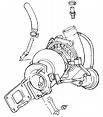|
 The
Factory Turbocharger The
Factory Turbocharger
The factory 2,2L 4-cylinder engine uses a Garrett Air Research
T-3 turbo, standard oil bushings, 0.63 AR "Lotus only"
turbine housing with integral waste gate, standard T-3 compressor
housing, and a 40 trim compressor wheel, oil fed and water cooled
(on most). This compressor section can flow 30 lb/min of air or
about 390 CFM at 15ºC. At this flow the unit can support
261 HP.
The
turbo consists of three main parts. The turbine section contains
the turbine wheel and this is where the exhaust flows through.
The compressor section contains the compressor wheel and is where
the intake air flows through. Lastly, the center section carries
the water and oil and has the shaft that connects the turbine
wheel to the compressor wheel. It also has the bearings, or bushings
as the case may be.
Garrett Air Research
The turbo in its stock form can flow enough air through the compressor
to sustain 15 psi of boost with a nominal discharge temperature
for only 7 seconds before the discharge temperature rises dramatically.
This is from a small compressor wheel which is a compromise between
spool up and performance. It has often been observed that you
can hold "1 bar" of boost, but as the RPMs rise the
boost falls off. This is due to the small compressor wheel working
outside of its limits. The turbine side can flow about 410 CFM
of exhaust gases before the back pressure rises beyond acceptable
limits.
Translation:
The engine can only make the stated 264BHP or 280BHP for about
6 seconds before the systems "catch up" with each other.
Then, as the intake temp rises, the exhaust back pressure rises
and the power falls.
The
engine, in its stock configuration, can only run at a sustained
247BHP constant.
LEA
RECOMMENDATION:
After
many months of Dyno testing on recommended Turbocharges, we have
used and tested a modified ball bearing turbocharger, using the
suppliers housing and also the Lotus factory turbocharger housing.
The
ball bearing unit is running a little cooler and provides a much
better top end results, however the extra horse power was not evident
as the car produced close to 250 HP @ the wheels HP with the original
exhaust housing as per the diagram below.
We
expect the cars to run better on the road as out MAT temperature
on the dyno was showing 62" C at some stages. If we take this
into account the car on the road should produce 15 to 20 extra HP
@ the wheels.
Our
team is still working on variety of other turbocharge designs on
a stock internal engine to achieve a better results.... Note the
graph below is showing HP at the wheels and not the crank or BHP
as the factory prefers to claim.

Contact
LEA for more information regarding Turbocharger upgrade
|
![]()